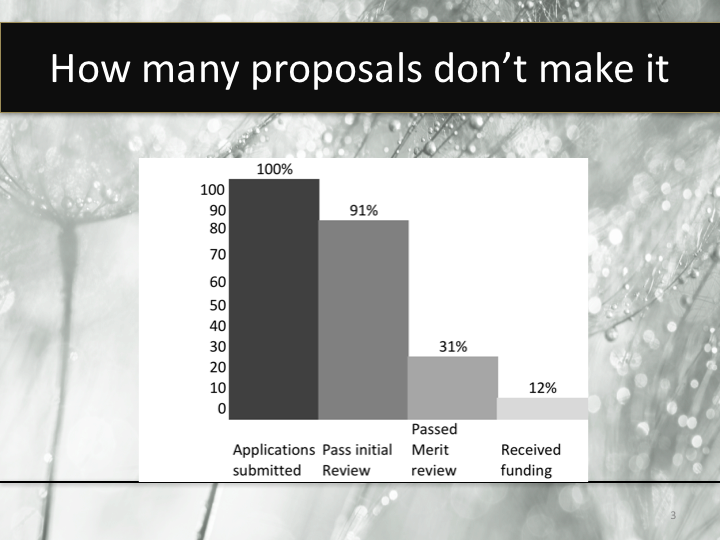Tutorial 7:
How are Phase I proposals evaluated?
There is a common misunderstanding that a “great” Phase I SBIR/STTR proposal can be submitted at any time and in any form and get selected for an award. In reality, there is a multi-step process through which your proposal must pass before it can be successful. Failure to meet an agency’s expectations and requirements at each step will likely lead to the elimination of your proposal.
The Department of Energy (DOE) evaluates Phase I SBIR/STTR proposals using a three step process: (1) initial screening, (2) merit review, and (3) final selection of awards. The initial screening step is used to determine if your proposal meets minimum requirements for the SBIR/STTR program and for DOE’s needs. This step includes an initial administrative screening, and an initial technical screening.
The administrative screening basically checks to see if you have followed the instructions in the Funding Opportunity Announcement (FOA) in preparing your proposal. This screening confirms that you have included all necessary forms and proposal sections and attachments, and are in compliance with simple requirements like page limits and submission deadlines. It also checks to see whether you have stipulated the Topic/Subtopic from the current DOE FOA to which your proposal is in response. The initial technical screening checks to make sure that you have provided ample depth and content to allow for a meaningful technical review, and that your proposal is for R&D and not for something like literature studies or marketing efforts.
If your proposal does not meet the requirements of the initial administrative and technical screenings, then it will be eliminated from further consideration (and therefore without consideration of its technical merits). A substantial number of Phase I SBIR/STTR proposals do not get past this initial screening step, so do not underestimate its importance! It is unfortunate how many proposals get eliminated at this step, with countless hours of proposal writing and preparation being wasted because the applicant did not pay attention to the details considered in the initial screening step.
The second step in the process of evaluating Phase I SBIR/STTR proposals is to conduct a Merit Review. This review is done by highly qualified technical experts who evaluate the technical merits of your proposal against three criteria:
- Strength of the scientific/technical approach (degree of innovativeness, evidence of a significant scientific/technical challenge, and thoroughness of the proposal)
- Ability to carry out the project (qualifications of your team members, merits of your work plan, consistency of project size with budget requested)
- Impact of the proposed project (technical/economic benefits, potential for marketable product, ability to attract post-SBIR/STTR funding)
Greater detail on what is considered under each of these criteria can be found in Part V.A. of the DOE FOA.
The third step is the final selection of Phase I awards. Because there are typically more highly scored proposals coming out of the Merit Review step than DOE can fund, hard decisions must be made regarding which of the strong proposals will be funded. Part V.A. of the DOE FOA explains this step by saying the DOE “Selection Official may consider program balance of fund distribution and needs of the technical programs.”
Given these three steps in the DOE Phase I SBIR/STTR proposal evaluation process, here are some ideas regarding how you can improve your chances of success at each step in the process:
Step 1. Initial screening: Follow the instructions carefully and completely. Involve another individual who has not participated in drafting the proposal to double check that you have addressed all requirements. Focus your proposal on a specific Topic/Subtopic in the current DOE FOA. Communicate with the Topic Author early in the process to assure that you really understand the intent of the topic.
Step 2. Merit Review: Focus your proposal on addressing the three merit criteria. Make it clear how your proposal meets each criterion and its components. For example, the first criterion requests evidence of the innovativeness of your idea and approach. Therefore, be sure to clearly state what is innovative about your technology and your research plan. Communicate with the Topic Authors and ask questions regarding the Topic/Subtopic to make sure you are aligning your proposal with that office’s interests and priorities.
Step 3. Final Selection: This step is really out of your control. The best thing you can do is work hard to get through the Step 1 – Initial Screening, and write a superior proposal so you receive an excellent score coming out of Step 2 -Merit Review. This will ensure that your proposal is among the fortunate finalists that will be considered in this final step.
It should now be clear why a “great” Phase I SBIR/STTR proposal may never be selected for award – poor compliance with the details that are important in the Step 1. Initial Screening is where the evaluation process of some such proposals is terminated. Others will get eliminated in Step 3 – Final Selection because there isn’t enough money to fund all “great” Phase I proposals.
Who are the decision makers at each step of a DOE Phase I SBIR/STTR proposal? There are a number of individuals who play a role. Step 1- administrative screening is conducted by DOE personnel in the SBIR/STTR Program Office. Step 2 – initial technical screening- is conducted by other personnel in the DOE Program Offices. There are 12 such Program Offices that participate in DOE’s SBIR/STTR programs, and that provide the Topics/Subtopics in the FOA.
The Merit Review Phase is performed by technical experts that are selected by these 12 DOE Program Offices. Roughly 50% come from the DOE Federal Laboratories, 30% from universities, 10% from the government, and 10% from the private sector. At least three technical reviewers will be involved in the Merit Review of each DOE Phase I proposal.
The final selection of awards is made by DOE personnel. Therefore, note that Merit Reviewers are very important to the DOE Phase I SBIR/STTR proposal review process, but they are not involved with award selection. They are not decision makers.
Quiz: Tutorial 7: How are Phase I proposals evaluated?
1
Really “great” Phase I proposals can still get awarded even if they fail to pass the Initial Review step.
Nice Work
Try Again
2
Which of the following statements is NOT accurate?
Nice Work
Try Again
3
When is communication with the DOE Program Office that is responsible for the Topic/Subtopic to which you are responding advisable?
Nice Work
Try Again
4
Commercialization issues like market potential and economic impact are part of the Merit Review of a Phase I DOE SBIR/STTR proposal.
Nice Work
Try Again


